With the nice weather here in Puyallup, we started construction on a new loudspeaker measurement array. THEN in typical fashion, the rain started !
Since there is no easy access to quick spherical measurements around here, we have always wanted build a nice array our selves. Years ago we had built a large two-axis robot monster which would hold boxes and measure a full sphere, one measurement at a time. That method was terribly slow, we wanted something fast, for R&D.
We checked out a few other array designs and were surprised how heavy and not really rigid they were. We decided on building a rib reinforced aluminum skin.
Although the simulations looked good, we haven't tested the back-scatter profile yet from this type of array frame geometry. I'm pretty interested to see the results when we get it all up and running.
I'll also start making some blog posts as we get further into the project. Once the array is done, we still have all of the motion control and staging for the device under test. If this type of array works, we also need to decide if we are going to go for the full 32 microphones 180 deg arc. Finally, we need to decide on the room/location to put the array.
If anyone in the area here is interested in working on the project with us, feel free to get in touch.
Mark
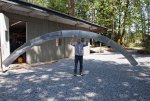
Tom McCauley holding up the array frame after finishing the riveting.
We had looked at other Aluminum microphone arrays and decided a light weight skin like an airplane wing might work better.
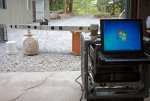
Computer connected to microphones for initial continuity testing.
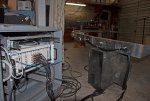
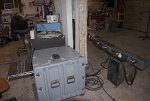
The rain started and we had to move everything inside.
Data Acquisition system hooked up getting ready to test out calibration system.
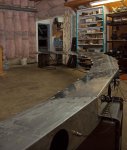
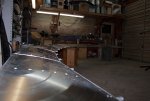
A couple more views of the array.
Since there is no easy access to quick spherical measurements around here, we have always wanted build a nice array our selves. Years ago we had built a large two-axis robot monster which would hold boxes and measure a full sphere, one measurement at a time. That method was terribly slow, we wanted something fast, for R&D.
We checked out a few other array designs and were surprised how heavy and not really rigid they were. We decided on building a rib reinforced aluminum skin.
Although the simulations looked good, we haven't tested the back-scatter profile yet from this type of array frame geometry. I'm pretty interested to see the results when we get it all up and running.
I'll also start making some blog posts as we get further into the project. Once the array is done, we still have all of the motion control and staging for the device under test. If this type of array works, we also need to decide if we are going to go for the full 32 microphones 180 deg arc. Finally, we need to decide on the room/location to put the array.
If anyone in the area here is interested in working on the project with us, feel free to get in touch.
Mark

Tom McCauley holding up the array frame after finishing the riveting.
We had looked at other Aluminum microphone arrays and decided a light weight skin like an airplane wing might work better.

Computer connected to microphones for initial continuity testing.


The rain started and we had to move everything inside.
Data Acquisition system hooked up getting ready to test out calibration system.


A couple more views of the array.
Last edited:
